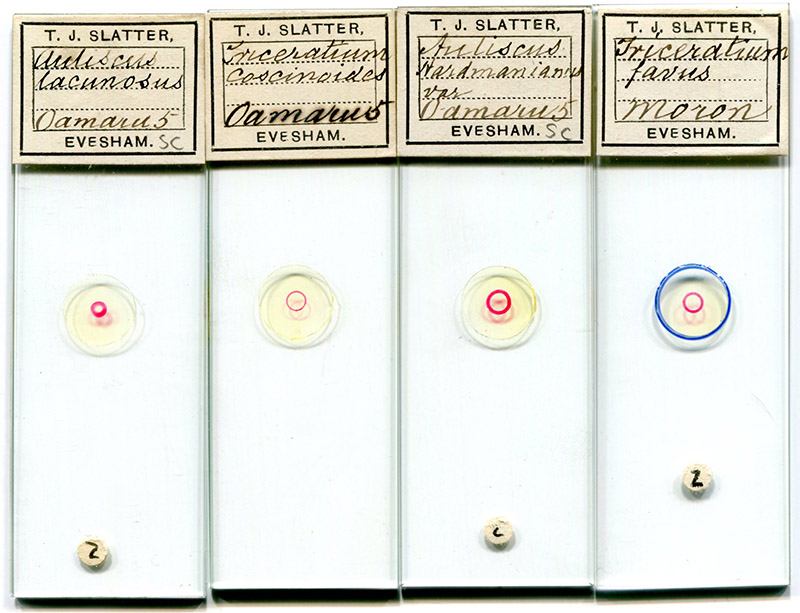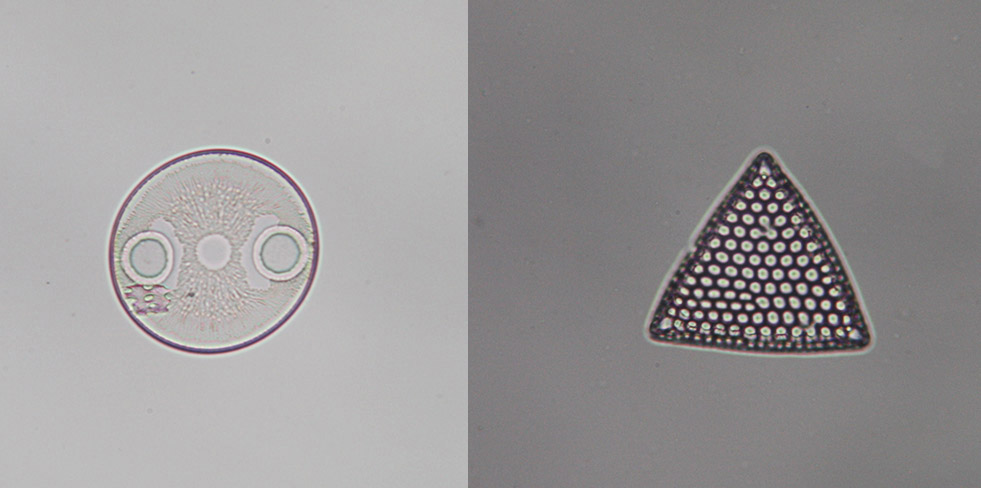
Figure 1. ca. 1880s slides by Thomas J. Slatter, each with a single diatom of the stated species, selected from gatherings of the Oamaru deposit, New Zealand, or the Moron deposit, Spain.
Thomas James Slatter, 1834 - 1895
by Brian Stevenson
last updated March, 2022
T.J. Slatter was a banker and an avid amateur scientist. He was particularly interested in local fossils, and amassed an important collection that was later acquired by the British Museum. He was an officer of his local Evesham Field Naturalists' Club, and a Fellow of the Geological Society of London.
Slatter is particularly noteworthy to microscopists for a series of high-quality slides of diatoms, likely prepared during the 1880s (Figures 1 and 2). Each slide contains a selected example of a single species. Preparing such slides required considerable skills in micro-manipulation and mounting techniques.

Figure 1.
ca. 1880s slides by Thomas J. Slatter, each with a single diatom of the stated species, selected from gatherings of the Oamaru deposit, New Zealand, or the Moron deposit, Spain.
Thomas James Slatter was born on October 20, 1834, in Gloucester. He was the third child, and only son, of Thomas and Anne Slatter. The elder Thomas was a relatively successful businessman. The baptism record of our microscopist described the father's occupation as "tanner". The 1841 national census reported the same occupation, while noting that the Slatter family employed a "female servant". The 1861 census listed the father as "corn merchant", and stated that he employed five men, while the family enjoyed the services of a general servant.
Thomas married Constance Edge during the summer of 1861, in Newton Abbot, Devonshire. The 1862 baptism record of their first child, also named Constance, reported Thomas' occupation as "banker's clerk". They then lived in Stour, Warwickshire. The 1871 census reported Thomas to be a "bank manager", with the family living in the "bank premises".
His wife, Constance, appears to have been ill as early as 1871. That year's census listed her as living with her parents in Evesham, Worcestershire. Thomas lived in Redditch, Worcestershire, with his unmarried sister Ann running the household of four Slatter children (their daughter Constance had died in 1864), along with a domestic servant and a nurse maid. The Slatter family afterward moved to Evesham. Constance died in the spring of 1864. Sister Ann remained with Thomas and his family until her brother's death.
Ann Slatter shared her brother's hobbies, and also gathered a considerable collection of fossils. The fossil coral Bathycoenia slatteri appears to have been named in her honor. In 1899, the British Museum "purchased from Miss Slatter 695 corals including several of the described specimens, and about 100 other Oolitic invertebrata".
In 1879, Thomas Slatter was elected as a Fellow of the Geological Society of London. A colleague later wrote, "to the regret of those who knew how careful he was as an observer, he was never the author of any work on geology, nor even of any contribution to a periodical on the geology of the district he knew so well".
A fossil ammonite, Aegoceras slatteri, was named in honor of Thomas.
He was also a long-time member of the Evesham Field Naturalists' Club. He served as President in 1879, 1881, and 1882, at least.
Thomas Slatter died on August 1, 1895. The Geological Magazine printed this obituary, "Thomas James Slatter, F.G.S., whose decease we have now to report, died at his house, The Drift, Evesham, on the 1st of August. He was a geologist whose knowledge of the locality in which he lived and worked was most intimate and reliable. He was born in Gloucester in 1834, but his family was for many years located at Stratton, near Cirencester. He was the cousin and intimate friend of John Jones, of Gloucester, whose contributions to pages of the earlier numbers of this magazine, and to the Proceedings of the Cotteswold Naturalists Club, were well known. Mr. Slatter commenced his business life as quite a young man in the Gloucestershire Bank, and then took up his abode in Evesham. He became successively manager of the Moreton-in-Marsh, Redditch, and Evesham branches of the Bank, but retired into private life a few years since, and, having built a new house on Green Hill, near the latter town, removed into it his extensive and most interesting collection of fossils. He was elected a Fellow of the Geological Society of London in 1879, but, to the regret of those who knew how careful he was as an observer, he was never the author of any work on geology, nor even of any contribution to a periodical on the geology of the district he knew so well. His death, by paralysis, took place in the house which he had so lately erected".
The British Museum wrote, "While serving as clerk and manager in various branches of the Gloucestershire Bank, Slatter studied the geology of the county, and made a large collection, chiefly of Jurassic fossils, which were carefully labelled in his own small and neat handwriting. On his retirement, he settled with his collection at Evesham. Many of the corals collected by himself and his sister Anne (q.v.) were studied by R.F. Tomes. Nearly 5000 specimens selected from this collection were purchased by the Museum from Slatter's executor in 1896. In the selection was included a fine antler of reindeer from the river-gravels near Evesham."
Of Ann, the Museum wrote, "Miss Slatter was sister to T.J. Slatter (q.v.) of Evesham. Having been attracted by numerous fossil corals scattered over the surface of a ploughed field at Fairford, Gloucestershire, she not only collected these, but subsequently obtained beautiful specimens from excavations made for the purpose in the underlying bed, which was at the base of the Cornbrash. She gave many of her specimens to Mr. Brown of Cirencester, who lent them, among others, to P. Martin Duncan for description. Miss Slatter's own specimens were examined, and some of them described, by Mr. R.F. Tomes, notably the type of Bathycoenia slatteri (Quart. Journ. Geol. Soc., 1883 and 1885). In 1899 the Trustees purchased from Miss Slatter 695 corals including several of the described specimens, and about 100 other Oolitic Invertebrata". Ann died on March 1, 1908. She had been born on May 22, 1829.

Figure 2.
Selected diatoms, (left) Auliscus lacunosus and (right) Triceratium favus, mounted by T.J. Slatter (see Figure 1).
Resources
Baptism record of Ann Taylor Slatter (1828) Parish records of St. Mary-de-Lode's, Gloucester, accessed through ancestry.com
Baptism record of Thomas James Slatter (1834) Parish records of St. Mary-de-Lode's, Gloucester, accessed through ancestry.com
Catalogue of the Fossil Fishes in the British Museum (1901) "Slatter Collection: A miscellaneous collection of fossils, chiefly from Gloucestershire, made by Mr. T.J. Slatter, F.G.S., of Evesham, purchased 1896", page xv
England census and other records, accessed through ancestry.com
The Geological Magazine (1895) Thomas James Slatter, F.G.S., page 479The History of the Collections Contained in the Natural History Departments of the British Museum (1904) , Vol. 1, pages 253, 257, and 325
The Midland Naturalist (1879) Evesham Field Naturalists' Club, page 48
The Midland Naturalist (1881) Evesham Field Naturalists' Club, pages 95-96
Probate of the will of Thomas Slatter (1895) "Slatter Thomas James of the Drift Evesham Worcestershire gentleman died 1 August 1895 Probate Worcester 7 October to Ann Taylor Slatter spinster Cyril Hugh Slatter architect and Beatrice Ida Slatter spinster Effects £5094 7s 3d", accessed through ancestry.com
Probate of the will of Ann Slatter (1908) "Slatter Ann Taylor of High-street Evesham Worcestershire spinster died 1 March 1908 at Evesham Probate Worceter 18 May to Cyril Hugh Slatter architect and Ethel Mary Smith (wife of Henry Josiah Smith). Effects £2997 4s 6d", accessed through ancestry.com
Tomes, Robert F. (1883) On the fossil Madreporaria of the Great Oolite of the Counties of Gloucester and Oxford, Geological Magazine, pages 136-137
Wright, Thomas (1886) Monograph on the Lias Ammonites of the British Islands, Vol. 1, page 374